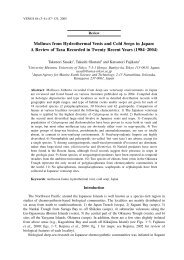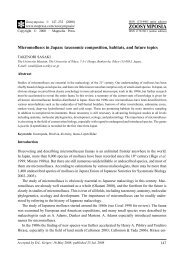Molluscan Research: Techniques for collecting, handling, preparing ...
Molluscan Research: Techniques for collecting, handling, preparing ...
Molluscan Research: Techniques for collecting, handling, preparing ...
Create successful ePaper yourself
Turn your PDF publications into a flip-book with our unique Google optimized e-Paper software.
32<br />
to physically spread the radula open. If the spreading does<br />
not succeed, place a drop of (distilled) water on the radula<br />
and try again. Only one part of the radula needs to be in a<br />
good orientation without too much damage. Breaking up the<br />
radula into segments and separating some teeth will increase<br />
the in<strong>for</strong>mation available (Figs 12D, E, G). For this fine<br />
manipulation holding one’s breath helps, because ribcage<br />
movement induces movement in the arms and hands. Mark<br />
the radulae by drawing a circle around them with an old<br />
needle or pair of <strong>for</strong>ceps.<br />
On glass slides, start by straightening out the radula. If<br />
it is long, you may cut it to get a better view of tooth bases.<br />
Small radula may be cut with two needles, crossing them to<br />
imitate a pair of scissors. Start with the front of the radula,<br />
because the posterior part of the radula is usually easier to<br />
work with, as the teeth are normally not fully <strong>for</strong>med. Pull<br />
out the front half with a needle to the edge of the water,<br />
preferably tooth side up and at a right angle to the edge.<br />
Quickly pull it out from the water with the needle, across the<br />
glass and up on the glue bed. This requires some practice.<br />
The intention is that the wet radula will soak the dry glue<br />
enough to make it stick and firmly attach the radula. Wet<br />
glue would invade the radula due to capillary <strong>for</strong>ces.<br />
While the radula is drying, after it has started sticking to<br />
the substrate but be<strong>for</strong>e it is dry, spread out the lateral teeth,<br />
preferably so they laterally stick to the glue. Use a needle<br />
bent like an ice-hockey stick. You can also use a moist triple<br />
zero paint brush, or a cat’s whisker in a holder works well <strong>for</strong><br />
smaller radulae. Small radulae usually stick without glue.<br />
The position of the radula can be marked with a fine tipped<br />
pen or dots of PVA glue.<br />
A dry, flat-mounted radula can either be torn in the<br />
outer part of the central field, approximately in the middle of<br />
the ribbon, or a few rows of the radula can be cut with a<br />
scalpel (Figs 12D, E, G) or torn with needles. Tearing a<br />
radula can provide a better view of the basal plates of the<br />
teeth and the teeth in the central field of Patellogastropoda.<br />
In vetigastropods, it will often also show diagnostic teeth at<br />
the boundary of the lateral and marginal tooth fields (lateromarginal<br />
plate), which are typically obscured one behind the<br />
other. Although the result of such destructive approaches is<br />
often unpredictable, it is recommended. Curving of the<br />
radula (e.g., by using wire mounting) will also provide good<br />
visual access to the base of the teeth, but a physical<br />
separation of rows by tearing the radula is usually superior.<br />
The merits and problems of wire mounting and tearing are a<br />
trade-off. Bradner and Kay (1995) suggested removing a few<br />
rows at the end of the radula <strong>for</strong> a better view of the teeth but<br />
we suggest that a tear in a more central to slightly anterior<br />
portion is more desirable, because of wear at the very<br />
anterior end of the radula. Manipulation of the radula other<br />
than standard mounting is not necessary <strong>for</strong> most<br />
neogastropods, because there is little overlap of the teeth.<br />
Transfer the radula from the last cleaning step to a drop<br />
of water on the chosen mounting substrate with a hooked<br />
needle. This has to be done fast, so the radula hanging on the<br />
needle does not dry. It dries faster in pure water than in<br />
KOH. A very small radula may dry in two to three seconds,<br />
GEIGER ET AL. (2007) MOLLUSCAN RESEARCH, VOL. 27<br />
depending on aerial humidity. If it dries, the radula will stick<br />
to the needle and may be difficult to remove, or it may<br />
crumble more or less irreversibly.<br />
Keep radular mounts in progress covered by an upsidedown<br />
glass bowl to avoid dust. To handle SEM subs, use<br />
designated stub <strong>for</strong>ceps; <strong>for</strong> stubs with a peg (e.g.,<br />
Cambridge), rather use the model <strong>for</strong> grabbing the peg, as<br />
opposed to the rim of the stub.<br />
Radula, histology and X-ray computer tomography<br />
In cases where the maximum in<strong>for</strong>mation should be<br />
obtained from a single specimen, a conscientious choice<br />
must be made as to which data is most important. External<br />
morphology can be obtained from histological sections<br />
through three dimensional reconstruction (e.g., Amira 3.1®),<br />
but radular structures are too fine to be accurately<br />
reconstructed; at most the major radula types (e.g.,<br />
docoglossage, rhipidoglossate, stenoglossate) can be<br />
identified.<br />
The most promising method <strong>for</strong> future radular studies<br />
seems to be X-ray computer tomography (e.g., Hagadorn et<br />
al. 2006), but so far the resolution (ca 1 µm: http://<br />
www.microphotonics.com/skymto.html) is too coarse <strong>for</strong><br />
micromolluscs. Regardless, it requires the most sophisticated<br />
instrument of its kind plus a cyclotron and involves much<br />
work on reconstruction.<br />
Three-dimensional reconstruction of animals is an<br />
exciting new avenue. Given that even basic anatomical<br />
features are difficult to observe in dissected micromolluscs,<br />
the only alternatives are histological serial sections with<br />
subsequent computer assisted reconstruction. Some of us<br />
have begun to apply these techniques to some specimens<br />
with 1 mm shells, the animals being half that size. We show<br />
here (Fig. 13) a section through the head region of Sinezona<br />
rimuloides (Carpenter, 1865) and the reconstructed pairs of<br />
odontophore cartilages, the pedal ganglia and the partially<br />
embedded statocysts (Fig. 12). The procedures are very<br />
labour intensive and require appropriate computer hardware,<br />
including a graphics tablet. However, it is possible to take<br />
cross-sections and to view the anatomy in any orientation. A<br />
dorsal view is shown in Figure 12. We expect software<br />
developments to make the techniques easier in their<br />
application as well as more reasonably priced.<br />
Optical photography<br />
Some specimens may not be placed in the high vacuum<br />
environment of the SEM and also, if colour is required, light<br />
optical imaging must be employed. Two main approaches<br />
can be pursued.<br />
SLR camera (film or digital)<br />
A general review on shell photography has recently<br />
been provided elsewhere (Geiger 2006b); Häuser et al.<br />
(2005) provided an overview on digital imaging of biological<br />
type specimens. Marco lenses usually provide 1:1<br />
magnification (occasionally only 0.5:1), which covers an




